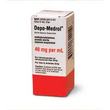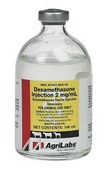Pronunciation
kort-i-co-STER-oids - Pronunciation guide
Brand Names
- Delta Albaplex®
- Depo Medrol Liquid
- Dexamthsone Injection
- Neo-Predef® with Tetracaine Powder
- Solu-Delta-Cortef®
- Tritop®
Description
 Cortisol and corticosterone are the natural corticosteroids produced by the adrenal glands, which are stimulated to produce corticosteroids by adrenocorticotropic hormone (ACTH). These hormones are essential for life and help regulate the body cells and organ systems.
Cortisol and corticosterone are the natural corticosteroids produced by the adrenal glands, which are stimulated to produce corticosteroids by adrenocorticotropic hormone (ACTH). These hormones are essential for life and help regulate the body cells and organ systems.
Corticosteroids are important in the metabolism of proteins, carbohydrates, and fats, and for their role in controlling inflammation. Since corticosteroids are vital to most functions in the body, their use in maximizing equine health and well-being, when properly prescribed and used, makes them some of the most important drugs available.
Usage
Corticosteroids are given to decrease inflammatory and immune responses in emergency situations, to treat anaphylactic reactions, to treat spinal cord trauma and shock, and are used topically to treat conditions involving the skin and eyes of horses.
Different medical conditions are treated with different corticosteroid drugs, based on the pharmacology, including the potency, speed of effects, and duration of action.
Dosage and Administration
Because of the variety of corticosteroid drugs available, the guidance of a veterinarian should be sought in all cases. Following are the dosage and administration guidelines of two commonly used corticosteroid drugs:
 Corticosteroids Corticosteroids |
||||
|---|---|---|---|---|
| Method | Dosage (click row for calculator) |
Concentration | Period | Duration |
| Dexamethasone - Intravenous or Intramuscular injection | 2.5-5 mg | 2 mg/ml | Daily | NA |
| Prednisolone Acetate - Intravenous1 or Intramuscular injection | 50-100 mg | 10 mg/ml | Every 12, 24 or 48 hours | NA |
| Prednisolone Acetate - Intravenous1 or Intramuscular injection | 50-100 mg | 50 mg/ml | Every 12, 24 or 48 hours | NA |
Notes:
|
||||
Side Effects
Problematic side effects of corticosteroids vary depending on the dose and duration of the treatment. The administration of corticosteroids can suppress the body's normal production of hormones, mask signs of infection, suppress immune response, cause horses to be more susceptible to bacterial or viral infections, cause laminitis, increase urination, lead to muscle wasting, and cause or worsen gastric ulcers.
Precautions
Electrolyte imbalances due to potassium and calcium losses can result when diuretics are given with corticosteroids. Risk of gastrointestinal ulcers may be increased if corticosteroids are used along with other drugs, such as NSAIDs, that are prone to causing ulcers. Corticosteroids should not be given intravenously with fluids containing calcium.
Corticosteroids should be avoided during pregnancy and lactation since excessive levels can cause birth defects. Because of their ability to suppress the immune system, corticosteroids should be avoided in young foals.
Horses that have pituitary gland problems should not be given corticosteroids.
The corticosteroids mentioned are FDA approved for use with horses and are prescription drugs. U. S. federal law restricts these drugs to use by or on the written or oral order of a licensed veterinarian.
Corticosteroids are forbidden in drug-free competitions and consultation with the individual regulatory group as to rules and regulations regarding therapeutic use and withdrawal times is necessary.
Interactions
Use of corticosteroids with diuretics increases the risk of electrolyte imbalances due to calcium and potassium losses.
Immune response to vaccinations may be reduced when corticosteroids are given at the same time.
Administering corticosteroids along with NSAIDs may result in gastrointestinal ulcers.
Overdose
Overuse or abrupt withdrawal after prolonged treatment with costicosteroids may contribute to development of Cushing's disease and Addison's disease. Both of these diseases are potentially fatal.
Doses of corticosteroids used in emergency medicine are higher than doses used under other circumstances.
In all cases, prescription by a knowledgeable veterinarian is necessary and the minimum dose should be adjusted and used for as short a time as possible.
Images
 Depo Medrol Liquid
Depo Medrol Liquid
 Dexamthsone Injection
Dexamthsone Injection
Literature
